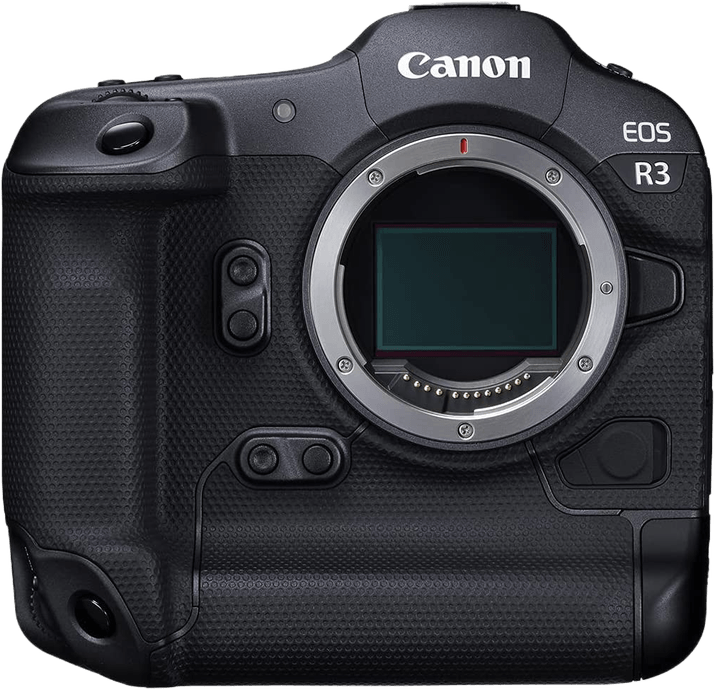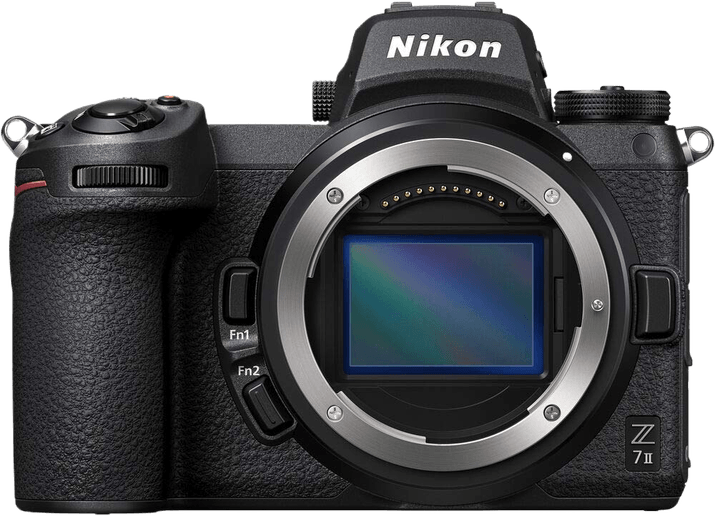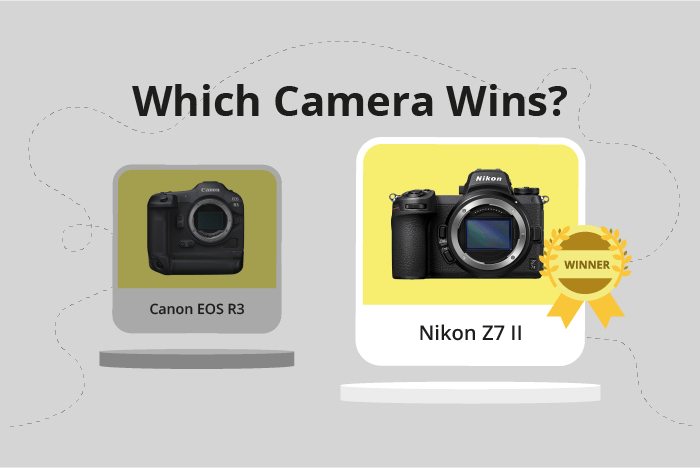Canon EOS R3 vs Nikon Z7 II Comparison
Canon EOS R3

Nikon Z7 II

The Nikon Z7 II edges out the Canon EOS R3 with a score of 85/100 compared to the R3’s 84/100. Both cameras are mirrorless and were released within a year of each other, with the Canon EOS R3 launching in 2021 and the Nikon Z7 II in 2020. They share similarities in their announcement dates, being only a month apart.
The Canon EOS R3 is a heavier camera, weighing 2.24lbs compared to the Nikon Z7 II’s 1.55lbs, and has larger dimensions of 150 x 143 x 87mm. This might appeal to photographers who prefer a more substantial feel. However, the Nikon Z7 II has a significantly lower launch price of $3399, making it a more budget-friendly option.
Considering their scores and specifications, the Nikon Z7 II offers a better value for money, while the Canon EOS R3 provides a more robust build. Each camera has its strengths, and the choice ultimately depends on the photographer’s preferences and priorities.
Canon EOS R3 vs Nikon Z7 II Video Performance
The Canon EOS R3 outperforms the Nikon Z7 II in video capabilities with a score of 96/100 compared to 91/100. Both cameras share some key video features, such as a maximum video frame rate of 120fps and built-in time-lapse functionality. However, the EOS R3 surpasses the Z7 II in terms of maximum video resolution and dimensions.
The Canon EOS R3 offers a higher maximum video resolution of 6K compared to the Nikon Z7 II’s 4K. Additionally, the EOS R3 has larger video dimensions at 6000 x 3164, while the Z7 II’s dimensions are limited to 3840 x 2160. This difference in resolution and dimensions allows the EOS R3 to capture significantly more detail and produce higher quality video footage.
Despite its lower score, the Nikon Z7 II still has some strong video capabilities. The camera matches the EOS R3’s maximum video frame rate of 120fps, making both cameras suitable for capturing fast-paced action and creating smooth slow-motion footage. Additionally, the built-in time-lapse functionality is present in both cameras, allowing users to create stunning time-lapse videos with ease.
Comparing the video capabilities of the Canon EOS R3 and the Nikon Z7 II, it is clear that the EOS R3 has the advantage with its higher video resolution and larger dimensions. This makes it a better choice for videographers who prioritize image quality and detail. However, the Nikon Z7 II remains a strong contender with its matching frame rate and time-lapse features. Ultimately, the choice between the two cameras will depend on the individual’s specific needs and preferences.
Canon EOS R3 vs Nikon Z7 II Features and Benefits
The Canon EOS R3 and Nikon Z7 II both have a feature score of 87/100, making them equal in this category. They share several common specifications, including a 3.2-inch screen size, touchscreen capabilities, flip screens, WIFI, and Bluetooth connectivity. However, there are differences that set these cameras apart, making one more suitable for specific users.
The Canon EOS R3 has a higher screen resolution, with 4,150,000 dots, which provides better image clarity and detail when reviewing photos. This camera also has GPS functionality, which is useful for geotagging photos and tracking your shooting locations. These advantages make the Canon EOS R3 more appealing to photographers who value image clarity and location tracking.
On the other hand, the Nikon Z7 II lacks GPS capabilities, which may not be a significant disadvantage for photographers who do not require geotagging. Additionally, the screen resolution is lower at 2,100,000 dots, which may not be a deal-breaker for those who prioritize other features. The Nikon Z7 II still offers excellent performance and quality, despite these differences.
In comparing the features of the Canon EOS R3 and Nikon Z7 II, the choice depends on each photographer’s preferences and priorities. The Canon EOS R3 offers a higher screen resolution and GPS capabilities, which may be essential for some users. Meanwhile, the Nikon Z7 II may still be a suitable choice for those who do not require these specific features. Both cameras are equally scored, and the decision ultimately lies in the hands of the user based on their individual needs.
Canon EOS R3 vs Nikon Z7 II Storage and Battery
The Canon EOS R3 outperforms the Nikon Z7 II in storage and battery with a score of 81/100, compared to the Nikon’s 71/100. Both cameras share common specs, including two memory card slots and USB charging capabilities. They also accept UHS-II compatible memory cards, with the Canon utilizing SD/SDHC/SDXC and CFexpress Type B, while the Nikon accepts SD, CFexpress Type B, and XQD cards.
The Canon EOS R3 excels with a longer battery life of 760 shots, using the LP-E19 battery type. In contrast, the Nikon Z7 II offers a battery life of 420 shots, relying on the EN-EL15c battery. This difference makes the Canon a more reliable choice for extended shooting sessions.
However, the Nikon Z7 II has a slight advantage in memory card versatility, accepting XQD cards in addition to SD and CFexpress Type B. This feature provides users with more options for storage.
Considering the storage and battery aspects, the Canon EOS R3 is the superior camera due to its longer battery life. The Nikon Z7 II’s additional memory card compatibility is a minor advantage but does not outweigh the Canon’s overall performance in this category.
Canon EOS R3 vs Nikon Z7 II – Our Verdict
Are you still undecided about which camera is right for you? Have a look at these popular comparisons that feature the Canon EOS R3 or the Nikon Z7 II:

